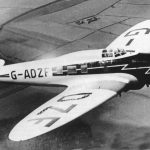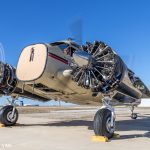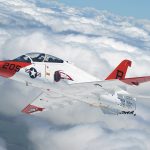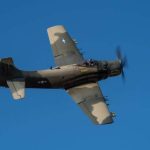

By January 1951, de Havilland Canada had become an entity all of its own, creating its own designs as opposed to simply building products designed by its parent company in the United Kingdom. Their efforts had paid off with the construction of the DHC-1 Chipmunk primary trainer and the DHC-2 Beaver, which was DHC’s answer to the prewar Noorduyn Norseman. Yet de Havilland Canada sought to build a larger version of the Beaver, which was designed to be a short takeoff and landing (STOL) transport for the Canadian north. Named the “King Beaver” during its design phase, the DHC-3 incorporated a longer fuselage, greater-span wing, and cruciform tail, with the seating capacity increased from six to eleven, and the Beaver’s Pratt & Whitney R-985 Wasp Jr radial engine was replaced with the addition of a single Pratt & Whitney R-1340 Wasp radial engine. On December 12, 1951, the first DHC-3 Otter prototype, CF-DYK-X, made its first flight. Soon afterwards, the Otter would be accepted into service with the Royal Canadian Air Force as a light utility transport and a search and rescue aircraft and would enjoy widespread commercial and military success around the world, with a total of 466 examples being produced.
In all, the DHC-3 Otter would see in numerous air forces around the world, including Argentina, Australia, Bangladesh, Burma [Myanmar], Canada, Chile, Costa Rica, Ethiopia, Ghana, India, Indonesia, Khmer Republic [Cambodia], New Zealand, Nicaragua, Nigeria, Norway, Panama, Paraguay, Philippines, Tanzania, United Kingdom, and the United States. In fact, besides the RCAF, the USA was the largest military operator of what they designated the U-1 Otter and operated them from Vietnam to Antarctica. In fact, one U-1 Otter, Bureau Number 144670, which was delivered to the US Navy on September 28, 1956, is in continual use with the US Navy Test Pilots School at NAS Patuxent River, Maryland and is the oldest aircraft in active duty with the US Navy today.
In addition to its military service, the DHC-3 Otter has had an extensive civil career up to the present day. Otters have been used for roles such as aerial photography, topographic surveys, search and rescue, utility transport, air ambulance, and aerial firefighting in a civilian capacity in Australia, Canada, Norway, Philippines, United States, Fiji, and New Zealand. Many Otters in civilian service have also been modified with turboprop engines, with the most common engine being used in these conversions being the Pratt & Whitney Canada PT6. Other engines fitted to DHC-3 Otters include the Walter M601 and the Honeywell TPE331 turbine engines, and the first stages in converting the Otter from reciprocal engines to turbine engines would also lead to the development of the de Havilland Canada DHC-6 Twin Otter.
Over 70 years later, the de Havilland Canada DHC-3 Otter remains one of the most rugged bush planes designed in Canada, and many of them are still in use throughout Canada and Alaska as STOL transports capable of flying groups of sportsmen in and out of the forests, lakes, and rivers of the Great North, and as long as there are people to maintain and fly these versatile planes, they will not be leaving the skies anytime soon.
Today in Aviation History is a series highlighting the achievements, innovations, and milestones that have shaped the skies. All the previous anniversaries are available HERE

































